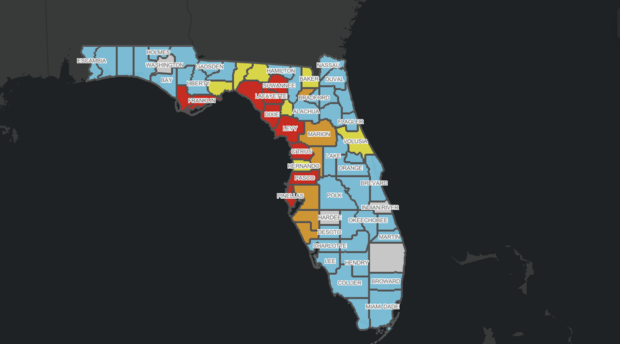Much of Florida's Gulf Coast is under an evacuation order – and a "king tide" could make flooding worse
Update: Hurricane Idalia made landfall in Florida's Big Bend region Wednesday morning. Read the latest here. Our earlier story is below.
Hurricane Idalia is barreling toward Florida and is expected to affect a large portion of the state and bring a massive storm surge. The flooding may be made worse due to a so-called "king tide." What is that and how is it affecting evacuation orders?
What is a "king tide"?
King tide is a non-scientific term to describe extremely high ocean tides, according to the National Oceanic and Atmospheric Administration. Tides are affected by the gravitational pull of the moon and sun, and are usually higher when the moon is new or full.
King tides are the highest tides of the year and normally occur twice yearly in coastal areas, causing unusually high flood levels and possible tidal flooding, according to the Environmental Protection Agency.
There will be a full moon on Wednesday, Aug. 30, the day Hurricane Idalia is expected to make landfall on Florida's Gulf Coast. NOAA projected higher tides on the dates of the full and new moons in August — including Aug. 30.
Sea levels are also typically higher in the late summer and early fall because of the changing weather patterns and warmer temperatures, according to NOAA.
Several areas of Florida are forecast to have their highest tides on Aug. 30, including Sarasota, which is on the Gulf Coast to the south of where the storm is expected to make landfall.
Idalia is forecast to move over the Carolina coastline on Thursday, and the North Carolina King Tides Project also forecasts a king tide there on Aug. 30.
Evacuation zones
Florida categorizes areas into different evacuation zones, with Zone A typically being the most vulnerable to flooding during a storm to Zone F typically being the last to evacuate.
Florida residents are urged to check if they live in an evacuation zone by using a map on the Florida Division of Emergency Management website.
As of Tuesday, there is a mandatory evacuation order for much of the Gulf Coast from Tampa Bay northwards — from Pinellas County, which includes St. Petersburg, north and west along the coast to Gulf and Franklin counties, which are east of Panama City. Some counties, like Hernando County, north of Tampa, and Volusia County on the East Coast, are under voluntary evacuation orders as of Tuesday.
The state division says the "greatest threat to life from a hurricane is storm surge flooding." Storm surge occurs when water levels rise due to a storm. This can cause extreme flooding — particularly in coastal areas and especially when it occurs at high tide, which is expected during Idalia.
Those who live in evacuation zones, live in mobile homes or unsafe structures or live in low-lying flood areas should leave the area when an evacuation order is in place. For those who don't live in these areas, it may be safer to hunker down at home during the storm.
How to prepare for evacuation
If you live in an evacuation zone and have been asked to leave the area ahead of a major storm like Idalia, the Centers for Disease Control and Prevention recommends packing up a few essential items before you head out, including cellphones, chargers, medicines and licenses or other forms of identification, as well as cash. All of these things can be put in an emergency supply kit that is easy to grab when you leave.
Before you evacuate, unplug appliances and try to turn off your home's electricity, gas and water, the CDC says.
Evacuees should heed instructions from local authorities and also look into which roads may be opened or already affected by the storm — and always avoid those that are flooding.
If you have animals, look for pet-friendly places to stay ahead of your departure or ask shelters for advice.
Whether you are planning to evacuate or not, prepare your home for a storm by gathering emergency supplies like food, water and flashlights and making sure your car's gas tank is full or, if you don't have a car, planning another means to help you evacuate if needed.
You can also help safeguard your house by boarding up windows and clearing your yard of things that can blow around in the wind.





